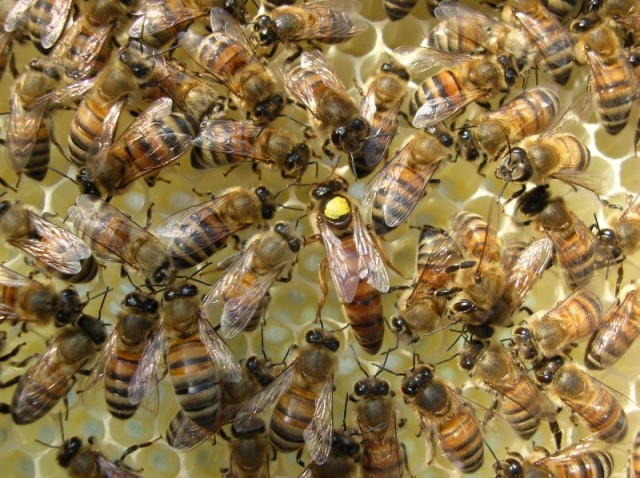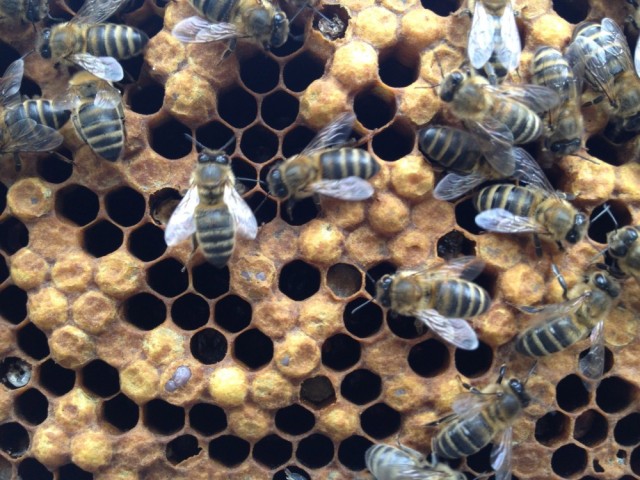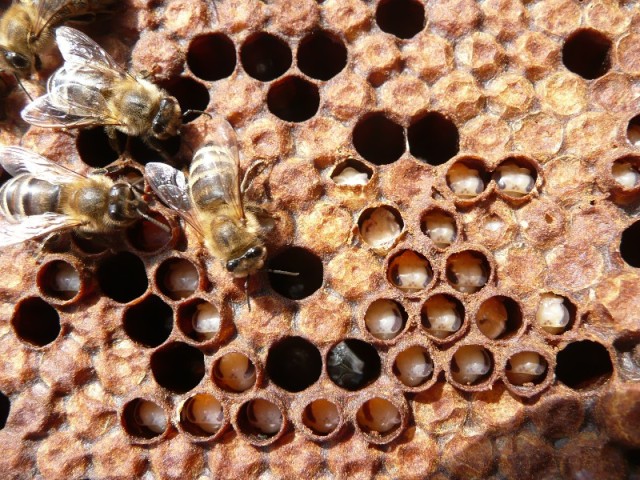I’ve now received my first set of feedback from my BBKA correspondence course tutor, Pam Hunter. She went through all my answers very thoroughly and gave me the additional advice “Try not to be dogmatic – ‘may’ rather than ‘will’ etc. Remember when you do the exam that those marking the papers are individuals and rarely is anything in beekeeping totally black and white so the examiners probably have their own take on many aspects!”
With that in mind, on to paper 2:
A1. why does requeening with queens from an non related strain sometimes reduce the incidence of viral diseases, e.g. Paralysis, in an apiary?
Sometimes viruses can be transmitted vertically from queens to their eggs; queens may gain some viruses from drones during mating. For this reason you would not want to replace a queen leading a colony with viral diseases with one of her daughters.
Additionally, some strains of honey bees display more hygienic behaviour than others, for instance increased hive cleanliness, continual cleaning of the queen, cleaning nursery cells before eggs are laid inside, removing diseased and dead bees rapidly and doing plenty of mutual grooming. Therefore, requeening with a queen selected from a hygienic strain could help produce more hygienic bees who keep down levels of diseases more effectively.
A2. patchy pepperpot brood is associated with several diseases and conditions. Suggest reasons for this.
The bees will perforate cappings to try and investigate larvae which they sense are dead or unhealthy. In the case of European Foul Brood (EFB) and other diseases affecting unsealed brood, worker bees may remove the dead larvae, leaving a patchy brood pattern. It is also possible that a queen is not laying in certain cells because there are EFB or American Foul Brood (AFB) scales present, adding to the patchy pattern.
Edit – comment from Pam Hunter 17/1/13 – inbreeding can give pepper pot brood – the empty cells are quite healthy and have been cleaned as the bees know if the larvae are diploid drones and will remove them.
A3. a) why is bald brood commonly found in colonies containing Greater Wax Moth larvae?
Bald brood occurs when cell cappings are removed whilst the larvae are still inside. The wax-moth larvae tunnel in straight lines through the comb just below the cappings and produce silken tunnels, to which their faeces and bits of wax become attached. The worker bees subsequently remove the cappings when they realise something is wrong. Luckily the honey bee larvae often remain healthy and pearly white, and usually pupate normally.

Bald brood with wax moth larvae activity. Courtesy The Food and Environment Research Agency (Fera), Crown Copyright.
The bees will sometimes remove the silk tunnels created by the larvae. The cappings are not always completely removed by the bees, so there may be a round hole in the capping or a slightly raised ridge at the edge.
b) sometimes bald brood is found in colonies where the wax moth is absent; account for this.
Some strains of honey bees have a genetic trait causing them to leave small patches of brood uncapped. If this is the cause of the bald brood, you will see small patches of bald brood rather than the straight lines caused by the wax-moth larvae. Varroa can also be a cause when hygienic bees remove cappings to get at the mites inside. Bearing this in mind, the FERA National Bee Unit photo below probably shows bald brood which has not been caused by wax-moth.
A4. write a paragraph on Neglected Drone Brood and Stone Brood.
Neglected drone brood may be due to a drone laying queen or laying workers. In both cases new workers are not being produced, only drones which cannot help raise the brood. This leads to a shortage of nurse bees, resulting in unsealed brood which may be neglected and dying.
Edit – comment from Pam Hunter 17/1/13 – Drone brood may also be neglected if the weather turns bad and there is a lot of other brood to look after but a shortage of nurse bees. Most likely early in the season if the weather was good and there are drone larvae around the edges of the nest.
The way to distinguish between a drone-laying queen and laying workers is that a queen will lay single eggs in the cell bottom, whereas laying workers have shorter abdomens, so multiple eggs may be present stuck to the sides of the cell. In these situations drones will be laid in worker size cells, so the resulting drone pupae will be abnormally small and emerge worker sized. The subtle sign distinguishing adult drones which were laid in worker cells is that they will look like workers, only with bigger, beadier eyes than their sisters.
Stone brood is a very uncommon disease; for this reason it’s rarely mentioned by beekeeping manuals and I’ve found it hard to find out much about it. You are unlikely to see it in your hives, so I’d be interested to hear from any beekeepers who have experience of it! It’s a fungal brood disease caused by the fungi varieties Aspergillus fumigatus, Aspergillus flavus and Aspergillus niger, which are commonly found in soil. When a bee larva takes in these spores they can hatch in its gut and penetrate the gut wall. The spores grow rapidly, killing the larva in the process.
Infected larvae become white and fluffy and die after the cells are capped. Eventually the fungus erupts from the larval remains and forms a false ‘skin’ which turns first yellow and then green as the bee’s body becomes covered with powdery fruiting fungal spores. At first stone brood has a similar look to chalk brood. However, after death stone brood infected larvae become hard and difficult to crush (hence the name ‘stone brood’). In contrast chalk brood mummies can be crumbled easily using your fingers.
Worker bees clean out the infected brood and the hive may recover depending on factors such as the strength of the colony, the level of infection, and how hygienic the workers are. In some cases adult bees can be affected, with their abdomens becoming hard. Interestingly, the Aspergilles fungus can also infect other animal species such as birds, and cause breathing problems for humans.
Whilst searching for images of stone brood online (I failed to find any reliable ones from trusted sources), I came across this beer named after it! Still, it sounds tasty for a beer named after a fungal disease –
“Up on the roof of the Lymestone Brewery, the Lymestone bees have been busy making the sweetest honey from local fields and gardens. Literally stung into action, Brad the Brewer has created this rich, dark beer from the Lymestone bees honey and the finest chocolate malt. Velvety chocolate gives way to a balanced bittersweet finish. Easy drinking and very moreish” – from the Beersay blog.
A5. describe briefly the lifecycle of Nosema.
There are now two species of nosema found in colonies in Britain, Nosema apis and Nosema ceranae. Nosema apis is a unicellular fungus parasite. It produces a spore that can survive in comb for a long time, although the spores are not as resistant to extreme temperatures as those of AFB.
Nosema ceranae is similar but used to be only a parasite of the Asian honey bee, Apis cerana. Unfortunately, as with varroa, the movements of beekeepers have caused it to be transferred to European honey bees (Apis mellifera) and arrive in Britain. This is particularly unfortunate as studies have revealed that European honey bees die more quickly from N. ceranae infections than N.apis infections. Queens infected with N. ceranae have been shown to die about three weeks after becoming infected by diseased worker bees in their colony.
How nosema spreads
Nosema spores get into an adult bee through its mouth; this happens as house bees clean up faeces from combs and frames, in the process unknowingly ingesting the nosema spores.
The spores invade the digestive cells lining the main digestive mid gut of the honey bee. They feed happily away on the content of the bee’s gut cells, rapidly multiplying within a few days, until the gut contains 30-50 million nosema spores once the infection is fully developed. This impairs the digestion of pollen, shortening the lifespan of the bee. The expanding number of spores also causes the bee’s gut cells to rupture, creating lesions in the lining of the ventriculus (ventriculus is another word for the midgut in insects). These lesions may facilitate the access of bee viruses to the internal haemolymph of the bee.
In winter and spring it may be too cold for the bees to fly, causing them to shed faeces on the comb, rather than during cleansing flights. Bees infected with nosema will shed spores in their faeces, which can then be ingested by their sisters, especially young bees cleaning cells and comb faces. Crushing bees during inspections should be avoided as this can release millions of nosema spores. This shows the importance of changing brood combs regularly – preferably annually, and all in one go by doing a shook-swarm or Bailey comb exchange. Changing only two or three brood combs at a time allows spores from the remaining combs to be transferred onto the new combs.
Nosema and dysentery
Nosema is very widespread but often goes unnoticed by beekeepers because the only noticeable symptom is that the colony could be slow to build up in the spring. Many beekeepers believe brown spots of dysentery on their hive is an indication of nosema, but in fact bees can have dysentery without having nosema, and vice-versa.
The connection is that nosema can be spread rapidly if the bees do develop dysentery, due to nosema spores in the dysentery faeces that worker bees come in contact with whilst cleaning the hive. Dysentery itself is caused by excess water accumulation in the rectum, for instance if the bees have been unable to fly for several days due to bad weather.
References:
- A Practical Manual of Beekeeping, David Cramp, Spring Hill (2008)
- Keeping Healthy Honey Bees, David Aston & Sally Bucknall, Northern Bee Books (2010)
- Mid Bucks Beekeepers Association, Module 3 exam notes
- National Bee Unit Beebase website
- The Honey Bee Around & About, Celia F Davis, Bee Craft Ltd, (2009)
Please do leave comments and feedback 🙂





This sounds like a great course. Something we could all benefit from. One problem with hygienic queens is that unless you live in an isolated area or can control your mating drones (also hygienic) the hygienic nature of your bees will be depleted. A best case scenario would be for all the beekeepers in a region to use hygienic queens.
LikeLike
Thanks Daniel. You’re right, it’s very difficult to maintain a hygienic queen line, especially in places like London where we have thousands of beekeepers. A beekeeper wanting to do that here would have to buy in a new hygienic queen each time.
LikeLike
An additional reason for patchy/pepperpot brood might be in-breeding. This leads to the queen laying diploid drone eggs which are eaten by their sisters as soon as they are detected by them.
LikeLike
Interesting, thanks Chris.
LikeLike
I have learnt such a lot reading your notes. The more I read the more it fascinates me. Have you a recommendation of books for me? I do not intend to keep bees immediately, so I do not need so much practical advice but the life-cycle, genetics and diseases interest me.
LikeLike
Bees have that effect on me too – no matter how much I learn, they continue to interest and surprise me! Jürgen Tautz’s 2008 book ‘The Buzz about Bees: Biology of a Superorganism’ is probably the most stunning book on bees I’ve ever read. It’s not at all about practical beekeeping but all about bee behaviour and communication, illustrated by lush close up photos.
LikeLike
Thank you for that. I had a word with Santa and he said as long as I went through Amazon on the Bumblebee Conservation web page, I’d get a surprise on Christmas Day. Excellent.
LikeLike
Ooh brilliant and a little present to the Bumblebee Conservation Trust too!
LikeLike
I am learning so much from you taking this course. I never heard of bald brood. Nature is pretty amazing in what one species does and how another can react.
LikeLike
I never had either! The poor bees get attacked by a seemingly endless variety of pests and parasites.
LikeLike
Part of the answer to A1 re. requeening is that bringing in a non-related strain will widen the gene pool. Nature abhores uniformity and lots of breeding from an homogeneous gene set leads to inbreeding. This weakens the colony which becomes more vulnerable to disease and genetic problems. You learn more about this in Module 6.
Very pleased to see you breaking the myth that Nosema is diagnosed by dysentery. Microscopic examination is the only definitive dianostic tool we have.
Some books may refer to the use of Fumidil-B as a preventative medicine for Nosema but that is now outlawed in the UK.
LikeLike
Sorry that should have been Module 7 – Queen Rearing
LikeLike
Thanks Barny, the inbreeding risk is a good point, will add it in my answer for my tutor. I used to use Fumidil-B in my autumn feed, but not this year. I expect this law change will add to the need to change brood comb as often as possible.
LikeLike
Hi Emily, I bought a book on bee ailments, I was blown away how may deceases .I wondered how can there be any bees left? I started with 10 hives.The new queens from California..brought to cold cold Michigan.Did not do very well the first winter….But Bees do evolve to survive..It is natures way..Then came Higher learning..we need to remember the bees have survived here for thousands of years with out our help.If you dwell on how is that so.you will have a lot more piece of mind….All my high bred queens are gone now,replaced by wild bees from the forest or where ever ,,But they are healthy bees and I dont have a science degree to know that..I sit and watch them for hours,,They are happy,buisy,seem to all be doing there jobs well.I use no chemicals .I do try to plant things around the farm that are known to be medicinal .Some times a little understanding of whats going on in the plant world,helps us to know whats going on in the Bee world..All related….Just some more stuff to think about,,If you ever get it all figured out I like to hear about it,Bob Fortner.”goldenrodbeenursery”
LikeLike
There are so many pests attacking the poor bees! But sounds like your bees are doing well now and benefiting from your loving care. Which medicinal plants have you planted? I imagine thyme is a good one, if you can get it to grow in your climate.
LikeLike
I have been doing research on the Isle of Wight disease (poor Mr Woodley was getting quite a lot of flack in some quarters of the beekeeping fraternity). The scientist Lesley Bailey was dismissive that the acarine mite was the course of the disease, and put it down to a number of things including chronic bee paralysis virus, starvation and poisoning. I see if I can sent you some stuff.
LikeLiked by 1 person